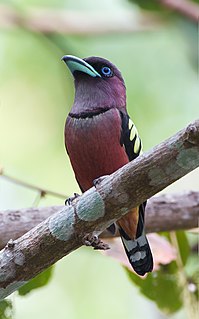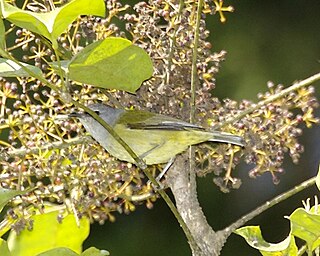
The lesser adjutant is a large wading bird in the stork family Ciconiidae. Like other members of its genus, it has a bare neck and head. It is however more closely associated with wetland habitats where it is solitary and is less likely to scavenge than the related greater adjutant. It is a widespread species found from India through Southeast Asia to Java.

The banteng, also known as tembadau, is a species of wild cattle found in Southeast Asia.

The Javan myna, also known as the white-vented myna, is a species of myna. It is a member of the starling family.

The Javan mongoose is a species of mongoose found in the wild in South and Southeast Asia. It has also been introduced to Hawaii, the Bahamas, Cuba, Croatia, Jamaica, Hispaniola, Puerto Rico, the Lesser Antilles, Belize, Honduras, Panama, Trinidad and Tobago, Colombia, Suriname, Venezuela, Guyana and Mafia Island. The western subspecies group is sometimes treated as a separate species, the Indian mongoose or small Indian mongoose.
The Java pipistrelle is a species of pipistrelle bat found in South and Southeast Asia, including Afghanistan; Bangladesh; Brunei; Cambodia; China; India; Indonesia; Laos; Malaysia; Myanmar; Nepal; Pakistan; Philippines; Singapore; Thailand and Vietnam. It favors human habitations.

The Javan plover is a species of bird in the family Charadriidae. It is endemic to Indonesia. Its natural habitats are sandy shores and intertidal flats. It is threatened by habitat loss.

The red-billed malkoha is a species of cuckoo in the family Cuculidae. It is found in Brunei, Indonesia, Malaysia, Myanmar, and Thailand. Its natural habitat is subtropical or tropical dry forests.

The banded broadbill is a species of bird in the Eurylaimidae family. It is found in Brunei, Cambodia, Indonesia, Laos, Malaysia, Myanmar, Singapore, Thailand, and Vietnam. Its natural habitat is subtropical or tropical moist lowland forests. It is a large broadbill (21.5–23 cm), with purple, yellow and black plumage. It eats predominantly insects, including grasshoppers, crickets, katydids, various beetles, caterpillars and larvae.

Mees's white-eye, also known as the Javan grey-throated white-eye or grey-throated ibon, is a species of bird in the family Zosteropidae. It is endemic to Java and Bali.

The Java mouse-deer is a species of even-toed ungulate in the family Tragulidae. When it reaches maturity it is about the size of a rabbit, making it the smallest living ungulate. It is found in forests in Java and perhaps Bali, although sightings there have not been verified.

Tragulus is a genus of even-toed ungulates in the family Tragulidae that are known as mouse-deer. In Ancient Greek τράγος (tragos) means a male goat, while the Latin diminutive –ulus means 'tiny'. With a weight of 0.7–8.0 kg (1.5–17.6 lb) and a length of 40–75 cm (16–30 in), they are the smallest ungulates in the world, though the largest species of mouse-deer surpass some species of Neotragus antelopes in size. The mouse-deer are restricted to Southeast Asia from far southern China to the Philippines (Balabac) and Java. Following recent taxonomic changes, several of the species in this genus are poorly known, but all are believed to be mainly nocturnal and feed on leaves, fruits, grasses, and other vegetation in the dense forest undergrowth. They are solitary or live in pairs, and the males have elongated canine teeth that are used in fights. Unlike other members of their family, the Tragulus mouse-deer lack obvious pale stripes/spots on their upper parts.

Xenodermus is a genus of caenophidian snakes. It is a monotypic genus, containing only Xenodermus javanicus, also known as the dragonsnake, Javan tubercle snake, Javan mudsnake, or rough-backed litter snake. It is considered to be rare, though no conservation efforts are currently active. Xenodermus javanicus is the single representative of the genus Xenodermus and demonstrates unique external morphology, e.g. characteristic dorsal scales, among xenodermatid snakes, which facilitates their distinguishing from different species. The snake is fully nocturnal and subsists on a diet of frogs. Xenodermus javanicus is a small non-venomous, semi-fossorial reptile. Dragonsnakes lay several clutches of 2-4 eggs each year in the rainy season (October–February).

Acrochordus javanicus, commonly known as the elephant trunk snake or the Javan file snake, is a species of snake in the family Acrochordidae, a family which represents a group of primitive non-venomous aquatic snakes. The species is also kept as an exotic pet.
The Java razorfish is a doubtful species of wrasse about which little is known. This fish gets the name "javanicus" from Java, Indonesia, from which the type specimen was supposedly obtained. Also, some fish have been reported to have been spotted in the Red Sea. The validity of this species is questioned pending further studies.
Trionyx javanicus may refer to:
Tyloxoles is a genus of beetles in the family Cerambycidae, containing the following species:
Tyloxoles boholicus is a species of beetle in the family Cerambycidae. It was described by Kriesche in 1927. It is known from the Philippines.
Tyloxoles discordans is a species of beetle in the family Cerambycidae. It was described by Newman in 1842. It is known from the Philippines.
Tyloxoles v-signatus is a species of beetle in the family Cerambycidae. It was described by Schwarzer in 1931. It is known from the Philippines.

Cyperus javanicus, also known as the Javanese flatsedge, is a sedge of the family Cyperaceae that is native to Indonesia and Australia.















